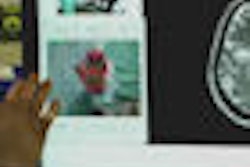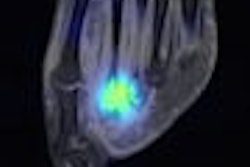Radiologists performing stack mode image viewing should be provided a variety of methods to navigate through the image slices, allowing them to choose the technique that works best for them, according to researchers from Simon Fraser University in Burnaby, British Columbia.
With 3D MR and CT data being displayed directly onto 2D image displays, stack mode viewing has become the preferred method for interacting with these 3D digital volumes, said Stella Atkins, Ph.D. It does suffer from drawbacks, however.
Radiologists experience problems with the huge number of 2D image slices to scroll through, and while alternative methods such as pseudo-3D or stereoscopic displays are being considered, they have not yet been adopted, Atkins said.
"It's actually easier to detect and measure anomalies by viewing a 2D slice in the 3D data," she said. "Furthermore, some data are always occluded if you're displaying something in 3D while in 2D. And 3D has many viewing parameters to adjust."
As a result, radiologists must continue to scroll and scroll and scroll, she said. She presented the Simon Fraser University research during a scientific session at the 2008 Society for Imaging Informatics in Medicine (SIIM) meeting in Seattle.
The researchers sought to study the computer-human interactions of radiologists scrolling through a stack of 2D slices, hoping to reduce strain and improve speed and accuracy. Three techniques were compared for scrolling: an ordinary mouse scroll wheel; a mouse in "click-and-drag" mode for fast scrolling, with the mouse scroll wheel used for fine adjustments; and ShuttleXpress (Contour Design, Windham, NH), a jog-shuttle wheel typically used in video editing.
The study team hypothesized that stack mode navigation through multiple image slices would allow users more control and more speed, in addition to reducing wrist and finger stress experienced during typical mouse-based interaction methods, Atkins said. The researchers also wanted to determine if a different user group -- undergraduate students -- would have similar performance and preferences to radiologists.
A test platform was developed for a "look-alike" radiology task to search for anomalies, featuring a stripped-down user interface and artificial stimuli of hyperintense spherical regions that were overlaid on 3D medical image volumes. Nine radiologists were included in the study, including three experts with five years of experience and six younger radiology trainee fellows.
Each participant was asked to perform the same anomaly detection task using all three techniques, performing three blocks of five trials (one block for each interaction technique). Each block had a total of eight anomalies.
There were typically 60 image slices in each volume, with a maximum of 101 slices in one of the test sets. The order of interaction techniques was counterbalanced in order to counteract learning effects, and each block began with a practice trial with three anomalies.
All nine radiologists were 100% accurate, although individual trial times were quite variable, Atkins said. One radiologist was over twice as fast as the slowest one to perform the same set of tasks.
The technique chosen had little direct influence on time. In addition, a significant learning effect over time was observed, especially for the first block, Atkins said.
Individual variability
In an attempt to look for sources of individual variability, the researchers consulted navigation charts that showed plots of image slice number against time. Radiologists typically use a "locate" pass followed by a "review" pass, according to Atkins. The locate pass times showed a similar pattern and individual variability to entire trial times, she said.
Individual trial times vary because some subjects are fast, while others are slow, she said.
In other findings, the interaction technique did significantly affect mean forward navigation rate, with the click-and-drag technique providing 9.4 slices per second, the jog wheel yielding 6.9 slices per second, and the mouse scroll wheel alone producing 5.4 slices per second.
From a questionnaire, the researchers obtained some background information on the participating radiologists. All nine radiologists normally use mouse-based techniques, and none of them had ever used a jog wheel before, she said. After the study, one preferred the jog wheel, six preferred the pure mouse wheel, and two preferred the mouse drag/wheel.
Two users said they disliked the jog wheel because they were not familiar with it, while one user thought the rotational movement of the finger on the jog might become tiring, Atkins said. Three users also thought the scroll wheel required too much finger movement; those were the ones who used the index finger to scroll, she said. One user said the scroll wheel caused finger strain.
The researchers also performed a pilot study involving eight student participants. In this trial, three students missed an anomaly. For those cases in which an anomaly was not missed, the mean times of students per trial were similar to the radiologists' first-pass mean times.
None of the students had ever used a jog wheel before, and three of them preferred it after the study, she said. Three preferred the pure mouse wheel, while two students favored the mouse drag/wheel.
Looking back at the researchers' original hypotheses, the jog wheel was indeed found to offer more control for users, reducing "overshoots," Atkins said. However, it was not found to be faster than the other techniques. The goal of reducing the wrist and finger stress experienced during typical mouse-based interaction methods remains a possibility, she said.
The researchers found a high variability of performance time within the radiologist study group, with no significant difference in either trial time per technique or first-pass trial time per technique.
"However, the rate of forward navigation using drag/wheel was significantly faster than other techniques," she said. "But because of the overshoot that resulted from going so fast without enough fine control, it turned out that the trial time was not significantly different."
Radiologists preferred familiar mouse techniques over the jog wheel, she said.
Future Simon Fraser University research will involve tests with larger datasets, more realistic stimuli, an increased training period to remove learning effects, and a programmed outer shuttle wheel for fast forward and reverse options, Atkins said. The researchers also will investigate other new interaction techniques for scrolling and clicking.
Atkins encourages radiologists to use their middle finger for mouse scrolling, allowing them to click with their index finger. She also suggests that users employ the distal two-thirds of the finger to scroll, rather than the fingertip alone. "This maximizes rotations of the wheel for each finger movement cycle," she said.
The whole forearm should also be utilized in the process of operating devices such as the jog wheel, according to Atkins. "Don't rest your hand on the ground," she said.
By Erik L. Ridley
AuntMinnie.com staff writer
August 18, 2008
Related Reading
New algorithm sharpens coronary artery images, July 14, 2008
CARS report: Imaging workstations key to patient-specific care, June 26, 2008
3D development outpaces facilities' readiness, June 23, 2008
Mayo pares PACS limitations with intelligent image routing, June 11, 2008
Advanced visualization's benefits come with integration challenges, April 7, 2008
Copyright © 2008 AuntMinnie.com




















